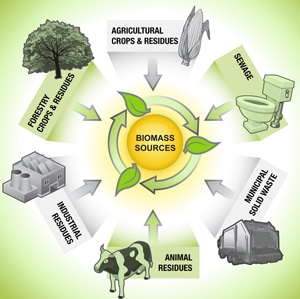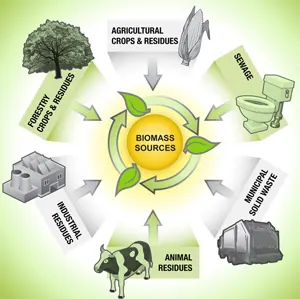
Biomass Resources
Biomass Resources and Biorenewable Resources
![]() The term Biomass Resources, sometimes referred to as biorenewable resources, are all forms of organic materials, including plant matter both living and in waste form, as well as animal matter and their waste products. As such biomass resources are generally classified as being either waste materials or dedicated energy crops.
The term Biomass Resources, sometimes referred to as biorenewable resources, are all forms of organic materials, including plant matter both living and in waste form, as well as animal matter and their waste products. As such biomass resources are generally classified as being either waste materials or dedicated energy crops.
A waste material can be any municipal solid waste and industrial waste material that has been discarded because it no longer has any apparent value to the user or which represents a nuisance or even a potential pollutant to the local environment. If the organic waste products from one process was used as primary source of feedstock in another process.
For example, materials such as waste cardboard, wood and paper recycled into newspapers, books and magazines, etc. If these waste materials were economically converted into electricity, heat, liquid biofuels, or chemicals, then they could be considered as a biomass resource rather than an unwanted waste stream.

Waste materials that would qualify as a biorenewable resource include agricultural residues, yard and garden waste, municipal solid waste, food processing waste, animal manure, etc. Existing landfill areas are now filled beyond capacity.
The search for new landfill sites for the dumping of solid waste is becoming increasingly difficult due to public protest. Finding new landfill sites away from urbanized areas means that the longer distance travelled from the city center increases the wastes transportation cost tremendously.
But the energy generated from waste cannot be ignored as a valuable bioenergy source. If effectively harnessed, the energy produced from wastes can be used to lessen the demand for energy generation using nonrenewable fossil fuel sources.
Furthermore, the generation of energy from solid waste materials brings extra significance by reducing the volume of the the unwanted waste, saving on landfill space and providing a biomass resource which would otherwise be of no value.
Solid Biomass Resources
So what types of solid waste materials qualify as a biorenewable resource.
- Agricultural Residues are the non-edible stalk type materials that remain after the harvest of the edible portions of the crops, such as corn, wheat, grain and sugar cane. Agricultural residues also includes plant leaves, husks, some roots and stems. The residues of dedicated bioenergy non-food crops grown for their starches, sugars, or oils for the conversion into bioethanol and biolubricants. The advantage of agricultural residues is that they do not require the use of additional land space because they are grown together with the food crops.
- Food Processing Waste is the effluent wastes from a wide variety of industrial processes ranging from breakfast and cereal bar manufacturers to fresh and frozen vegetable manufacturers to alcohol breweries. These residues and wastes can be in the form of either dry solids or watery liquids. Fermentation of liquid wastes and oils from food processing can produce Ethanol.
- Municipal Solid Waste this is the items that are thrown away in the garbage and trash and is collected by the dustbin men or sent to the recycling centre. Municipal solid waste such as particularly paper, cardboard, and discarded food products, is an attractive source of endless biomass feedstock. However, not all municipal waste is suitable as a biomass resource, especially metallic and plastic waste.
- Animal Waste from farms, ranches, slaughterhouses, fisheries and dairies or any concentration of animals into giant livestock farming facilities produces large amounts of manure and sewage sludge. Liquid sewage, animal wastes, and also human waste from urban areas, provides a constant source of chemical energy and gases which can be converted into electrical power at these wastewater treatment plants. The treatment of animal waste produces combustible methane and biogas which can then be used for heating and transportation.
The management and disposal of solid waste has become one of the major problems we are facing today. An increase in the volume of unwanted waste is one aspect of the current environmental crisis. Other than the the difficulty in characterising the waste material, due in part to its variable and complex composition, many waste materials share a few common attributes with each other, with the principal one being their low cost.
Because of this, solid waste materials have little or no apparent economic value and can therefore be acquired for little more than their cost of transportation. In some cases, waste is regarded as a negative cost due to the every increasing costs of skip hire for solid waste disposal or the restrictions on the disposal of certain types of wastes at landfill sites, many companies or households are only to happy to pay someone to dispose of their waste as a biorenewable resource for processing.
Clearly, waste materials which can be reprocessed into biomass feedstock for use in an energy conversion process are therefore no longer classed as an unwanted waste material with the demand for these new-found renewable biomass resources on the increase. As waste now presents itself as an attractive biorenewable resource, many now demand payment for their waste. Then those companies or households that generate the waste now view themselves as waste suppliers turning what was once a negative cost into a positive profit.
But as well as using waste materials as a biomass resource, dedicated energy crops can be grown specifically as an energy source. These dedicated energy crops are not only greener and cleaner with respect to solid waste materials, but their use represents a closed and balanced carbon cycle with regards to atmospheric carbon dioxide.
Dedicated Biomass Energy Crops
Until now, biomass energy crops have been largely ignored in favour of growing food crops to feed people and animals, but as fuel prices increase and fossil fuel supplies run low, interest is now increasing as the economics of extracting fossil fuel energy becomes more expensive and complex. But as well as using the waste of agricultural crops, it is also possible to grow crops specifically for the production of energy in the form of energy crops.

